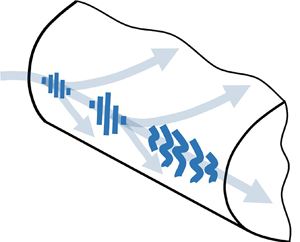Article contents
Instability of the attachment line boundary layer in a supersonic swept flow
Published online by Cambridge University Press: 23 December 2021
Abstract

Theoretical analysis of attachment-line instabilities is performed for supersonic swept flows using the compressible Hiemenz approximation for the mean flow and the successive approximation procedures for disturbances. The theoretical model captures the dominant attachment-line modes in wide ranges of the sweep Mach number  ${M_e}$ and the wall temperature ratio. It is shown that these modes behave similar to the first and second Mack modes in the boundary layer flow. This similarity allows us to extrapolate the knowledge gained for Mack modes to the attachment-line instabilities. In particular, we find that at sufficiently large
${M_e}$ and the wall temperature ratio. It is shown that these modes behave similar to the first and second Mack modes in the boundary layer flow. This similarity allows us to extrapolate the knowledge gained for Mack modes to the attachment-line instabilities. In particular, we find that at sufficiently large  ${M_e}$, the dominant attachment-line instability is associated with the synchronisation of slow and fast modes of acoustic nature. Point-by-point comparisons of the theoretical predictions with the experiments of Gaillard et al. (Exp. Fluids, vol. 26, 1999, pp. 169–176) demonstrate that at
${M_e}$, the dominant attachment-line instability is associated with the synchronisation of slow and fast modes of acoustic nature. Point-by-point comparisons of the theoretical predictions with the experiments of Gaillard et al. (Exp. Fluids, vol. 26, 1999, pp. 169–176) demonstrate that at  ${M_e} > 4$, the theory captures a significant drop of the transition onset Reynolds number, which is below the contamination criterion of Poll
${M_e} > 4$, the theory captures a significant drop of the transition onset Reynolds number, which is below the contamination criterion of Poll  $({R_\mathrm{\ast }} = 250)$ at
$({R_\mathrm{\ast }} = 250)$ at  ${M_e} > 6$. This contradicts the generally accepted assumption that the attachment-line flow is stable for
${M_e} > 6$. This contradicts the generally accepted assumption that the attachment-line flow is stable for  ${R_\mathrm{\ast }} \le 250$. The theoretical critical Reynolds numbers lie well below the experimental transition-onset Reynolds numbers. Stability computations using the Navier–Stokes mean flow and accounting for the leading-edge curvature effect do not eliminate this discrepancy. Most likely, in the experiments of Gaillard et al., we face with an unknown effect that does not fit to the concept of transition arising from linear instability.
${R_\mathrm{\ast }} \le 250$. The theoretical critical Reynolds numbers lie well below the experimental transition-onset Reynolds numbers. Stability computations using the Navier–Stokes mean flow and accounting for the leading-edge curvature effect do not eliminate this discrepancy. Most likely, in the experiments of Gaillard et al., we face with an unknown effect that does not fit to the concept of transition arising from linear instability.
Information
- Type
- JFM Papers
- Information
- Copyright
- © The Author(s), 2021. Published by Cambridge University Press
References
- 3
- Cited by


